New perk! Get after it with local recommendations just for you. Discover nearby events, routes out your door, and hidden gems when you sign up for the Local Running Drop.
Exploring the unsung canyons, waterfalls and hot springs of northern Iceland
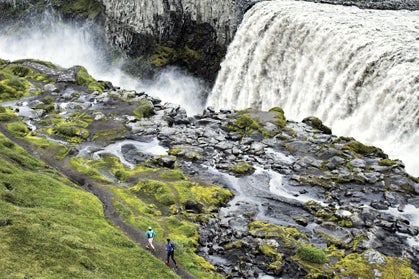
Running next to Dettifoss, Europe’s most powerful waterfall. Photo by David Clifford.
We’d been running for about an hour when we came across the dead bird. It stopped me in my tracks, while Bjarni—my trail guide for the day—continued running.
“Oh, sad,” I called out to him, then bent down to examine the large bird more closely—or what was left of it. Face down in the grass to the side of the trail, its body was nothing but a picked-over skeleton, with all its feathers still fully intact, splayed out to each side like a pair of angel wings at a costume store.
“Yes,” Bjarni said, neither breaking stride nor looking back. “A good reminder of how harsh nature can be.”
I was on day three of my trail-running explorations in the land of fire and ice—and only just beginning to adjust to Icelanders’ nonchalance about the dangers of its wild areas. Having grown up in safety-obsessed, lawsuit-gung-ho America, I found Iceland was taking some getting used to.
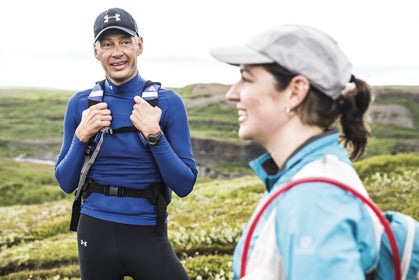
Einar and the author rest and catch their breath. Photo by David Clifford.
Later that day, Bjarni took me to a steaming, milky blue lake that—despite a swath of No Swimming signs—he said he enjoyed taking dips in with friends.
“You just have to be careful,” he explained, “because of the boiling mud on the bottom. It’s easy to get stuck in.”
When I asked if anyone had ever been injured there, he told me that last year, a friend’s leg had been sucked into the scalding mud below the opaque surface of the lake. He suffered third-degree burns.
“So you don’t swim there anymore?” I asked.
“No,” he chuckled. “We still do.”
The lake, I felt, was a metaphor for all of Iceland—beautiful and captivating, in a stop-you-in-your-tracks sort of way. Breathtaking. Irresistible. But with unseen dangers never far from the surface.
Several days before, the slogan of a billboard ad in Reykjavik had caught my eye: “Respect Nature. There’s no guarantee she’ll respect you back.
Sparsely populated Iceland, which is considered a part of Europe, is about 40,000 square miles—roughly the size of Tennessee, with 1/20th its population.
In many ways, it is a remarkably safe country for travel—and trail running. The crime rate is low. Hitchhiking is common, easy and generally considered safe. English is nearly as prevalent as the Icelandic tongue, an Old Norse language.
In the wilderness, there are no bears, cougars, snakes or poisonous insects. The abundant water from streams and waterfalls requires no filtering to drink. The main dangers, Lonely Planet warned me, would be capricious weather, geological hazards and the roads—which suffer from erratic drivers, blind rises, meandering sheep and abrupt changes from pavement to gravel.
Otherwise, the only other major woe for North American vacationers is the robust Icelandic krona (ISK). A pint of “cheap” beer will cost you the equivalent of $10; dinner at a casual restaurant $30 to $40.
I landed in Keflavik International Airport—about 40 kilometers outside of Iceland’s capital, Reykjavik—early on a cold, rainy Saturday morning in July. Thanks in part to IcelandAir’s “free stopover” option on all flights between North America and Europe, international flights arriving in Keflavik Airport have grown by 25 percent in the last year alone.
Despite a national economic crisis in 2008 that Icelanders still speak of with a shudder, the economy is bustling with tourism. Keflavik feels a bit like the arrival hall of a Disney theme park designed for grown-ups, with private buses (equipped with wi-fi!) that sweep up tourists and whisk them away for whatever adventures strike their fancy. The smorgasbord of options includes helicopter glacier tours, Icelandic horse rides, waterfall tours by jeep and dips in the infamous Blue Lagoon—literally a spill pool for the nearby Svartsengi geothermal power plant—that sees close to 600,000 tourists per year. Iceland’s total population is 320,000.
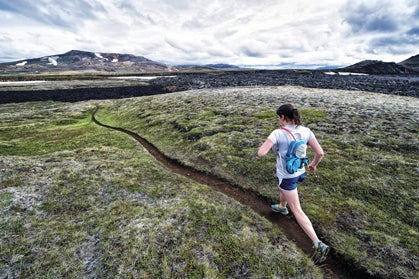
The author cruises singletrack near Lake Myvatn. Photo by David Clifford.
My plans included departing from the beaten path—that is, anything within a two-hour drive of Reykjavik in southwest Iceland—to explore trail running in the north. Documenting the adventure was pro photographer David “Cliffy” Clifford. We rented a car, and reached out to a couple local runners in northerly towns who’d agreed to show us around their favorite trails.
My greatest ambition in the north was to run the 33-kilometer Detifoss Trail in Vatnajökull National Park. The route goes from Europe’s most powerful waterfall, Dettifoss, to Asbyrgi, a canyon scooped out by glaciers after the last Ice Age into a dramatic horseshoe of steep, basalt cliffs. Local folk legend has it that Asbyrgi is the capital city of the huldufólk—“hidden people,” or elves—who reputedly live among the rock’s cracks and crevices.
I’d enlisted the help of Arctic Running, a fledgling, trail-running-tour company begun by two passionate trail runners, Inga Sigurðardóttir and Örn Haraldsson. The night before tackling the Dettifoss Trail, Örn invited Cliffy and me to join him and his wife for a concert in the town of Akureyri, which would serve as base camp for us during our explorations. At the locals’ favorite bar and music venue, the Graenhatturin (“The Green Hat”), we all got to know one another over cold Kaldi lagers and between singer-songwriter Eivör’s haunting folk compositions.
Örn told us he’d only been running trails for a few years. “Before that,” he laughed, “I just ran after sheep.” Aside from wanting to share the beauty of Iceland’s wilderness with fellow trail runners, Örn said one goal of Arctic Running is to help disperse the environmental impact of Iceland’s swelling tourism industry by inviting visitors to the less-traveled north.
He spoke passionately about preserving the country’s vulnerable wilderness, explaining how the government has made deals with foreign corporations and aluminum-smelting companies that have ravaged some of Iceland’s most beautiful corners. Örn’s dream is to share the wild, natural beauty of Iceland—not just manufactured tourist experiences like the Blue Lagoon—with visitors so that they may grow equally invested in preserving it.
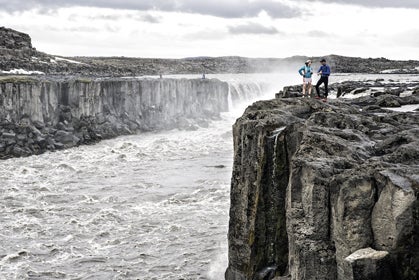
Taking in the views and mist around Sellfoss at the beginning of the day’s adventure. Photo by David Clifford.
The following morning, Cliffy and I met up with Einar Sigurjónsson, a tour guide with Arctic Running. He would run the length of the trail with me, while Cliffy would meet us at several points along the way to take photos. Initially, I’d been hesitant to explore Iceland with a tour company; I didn’t want some coddled, whitewashed tourist experience.
But, within minutes of Cliffy waving us off into the gray fog, I knew there’d be nothing coddled about our day’s tour. Tall, lanky and wearing beat-up Asics road shoes, Einar ran with long strides that I struggled to match. His face was deadpan, with a natural sternness to it—but when he smiled, it was a broad, yawning, contagious sort of smile, exposing a gap on the side of his teeth. A silver cap gleamed in the space between.
A mile or so into our run, the trail forked, with no directional signs. Einar guided us to the path on the right, explaining tersely, “The other way is for people who are afraid of heights.”
Within minutes we were peering over the edge of a steep, rocky ledge. Yellow posts that demarcated the trail poked up haphazardly between loose-looking boulders and jagged basalt. A thick, fixed rope cascaded down the rocks to help us descend to the bottom of the canyon, where the trail continued.
As I looked down and contemplated my chances of survival, Einar pointed to the snaking, turquoise river below, at least 30 feet across, raging with rapids. “After this,” he said, “We cross the river.”
My heart rate and eyebrows shot up in alarm. Einar grinned. I let out a cautious chuckle, unsure whether his grin meant, “Haha, just kidding,” or “Haha, welcome to Iceland; things are about to get real.”
Fortunately, the former was the case. After dusting off our hands from the rope descent, Einar pointed me down a smooth, singletrack trail winding along our side of the river. “You lead now,” he said. “Then you get to see all the scenery, instead of just my back.”
Though there had been some crowds at Dettifoss, the rest of our route was an exercise in solitude. Aside from seeing a lone through-hiker, and a handful of waterfall gawkers whenever we passed car-accessible viewpoints, we had the trail to ourselves.
We often ran in silence, punctuated only by my exclamations as we rounded bends in the trail and my eyes fell upon new sights—50-foot rock spires, silver-black basalt caves, waterfalls cascading through meadows of wildflowers or spilling over edges of the canyon. Like a chameleon, the landscape reinvented itself with every bend in the trail. In the span of a single mile, I felt as though we’d gone from running the verdant, green hills of Ireland, to dodging craters on the Moon, to hunting for mythical creatures in the Shire of Tolkien’s Middle Earth.
“This is freedom!” Einar yelled from behind me, in a rare, exuberant outburst. I glanced over my shoulder to catch sight of his grin before we bombed down the next stretch of singletrack.
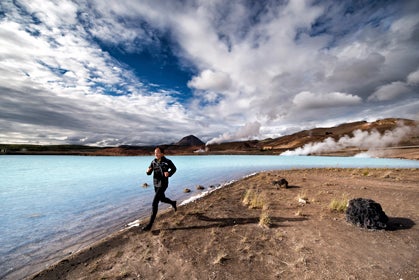
No swimming allowed in this geothermal reservoir near Myvatn. Mount Krafla looms in the distance. Photo by David Clifford.
Sometimes, Einar chatted casually about himself and his homeland. A schoolteacher nine months out of the year, he was making the most of his long summer days. He’d done a 90-kilometer trail run the day before, and, the next day, planned to begin running across the entire country. The 330-kilometer, north-to-south route he’d plotted would pass through the desolate center of Iceland.
He also spoke of how drastically Iceland has changed in the past 50 years—from the quiet, rural island of his childhood to a country of paved roads and tour buses. After climbing down another fixed rope to our finish line in the belly of Asbyrgi canyon, he waxed nostalgic about having camped in the canyon as a kid. More recently, in the summer of 2006, Iceland’s famed ethereal “post-rock” band Sigur Rós, played an open-air concert there.
Exhausted at the end of our run, we piled into our rental car for the sunset drive back to Akureyri—at 10 p.m. As Cliffy drove, I promptly passed out in the back seat—only to awaken to Cliffy gently shaking me, the car stopped.
“How do you feel about geothermal hot springs?” he asked.
I sat up and looked around. Our car was perched atop a hillside blanketed in purple lupine, overlooking the ocean. In front of our car, I could barely make out an outdoor tub and bathhouse underneath a thick cloud of steam. Though my watch indicated over an hour had passed since we’d left Asbyrgi, the sun still hung just above the horizon, a brilliant red orb painting the scene in fiery light.
“Is this real?” I asked groggily.
“Oh, it’s real,” Cliffy grinned.
The three of us piled out of the car and made quick work of taking the requisite shower (sans-swimsuit—a rule of Icelandic baths that you don’t want to break), then changing into our swimsuits and climbing into the thermal baths—two oversized aluminum tubs filled with steaming hot mineral water drawn up from the earth. “These are old cheese-making basins,” Einar explained. “Locals maintain the baths here now.”
Several men and women lounged in the waters, welcoming our arrival with a nod and an offer to swig some golden liquid from a plastic bottle they were passing around—homemade schnapps, we learned, made with Icelandic moss and juniper berries. It went down smooth.
As the hot water soothed my tired muscles and I pondered the good karma that had brought me to this moment, I asked Einar, “So, when did you get into running?”
He chuckled. And with the same air of nonchalance he’d used when mentioning his plans to run across Iceland the next day, he replied, “Oh … two months ago?”
By the time Cliffy and I got back to Akureyri for the night, post-soak, post-dinner, it was 2:30 a.m. The sun was beginning to come back up again, the soft yellow of sunrise blending with the deep red streaks still left over from sunset. No one was at the front desk of our guesthouse to check us in, so we picked out cozy-looking couches in the lobby and quickly fell asleep.
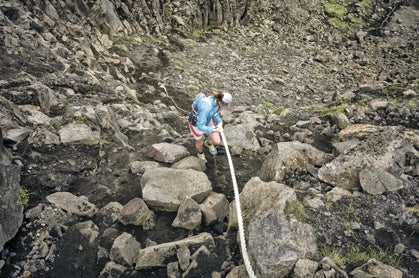
Fixed ropes at several steep points along the Dettifoss Trail aid runners and hikers. Photo by David Clifford.
Infectious enthusiasm for their country is a universal trait among Icelanders—and, particularly, the trail-running ones. Our local guide
The following day, Bjarni Jónasson, was no exception.
I’d been put in touch with Bjarni through a friend of mine in Seattle, Tom Norwood—a lifelong cyclist who’d been turned onto running through Christopher McDougall’s Born to Run, and who’d first convinced me to convert from pounding pavement to running trails nearly five years ago.
Bjarni was like the Icelandic incarnation of Tom—an entrepreneurial ball of energy, devoted father and a lover of the outdoors with a midlife transformation story that could be attributed to McDougall. Blond, freckled and with an often-grim face that, like Einar’s, could fold into a smile at a moment’s notice, Bjarni had read Born to Run several years ago, and been inspired to quit smoking and pick up running.
“I don’t do ultras,” he told me. “I just like being able to go out and do trails, maybe a 10K here and there, and not get hurt. I still don’t quite know why I run. I guess, like many people, I just hope that by continuing to do it, I’ll move closer to the answer.”
Bjarni heads up the local recreation center and swimming pool in Reykjahlið, a town of about 300 residents on the shores of Lake Myvatn, about an hour east of Akureyri. We met there, where he showed off his fledgling running shop, which imports and sells gear from Hydrapak, Newton Running, Luna Sandals and Craft. Bjarni immediately regaled us with his schemes to foster a greater trail-running community in Iceland. He hopes to establish a community hub for locals passionate about being active in the outdoors—perhaps combine a running shop with a café, he told us. Group runs, trail maps and information, local races—Bjarni had big plans for Reykjahlið.
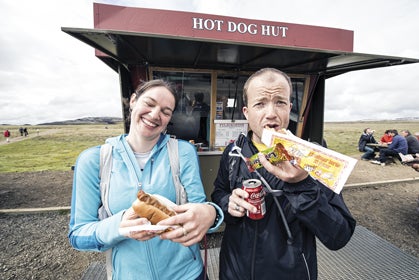
The author and Bjarni sample some of Iceland’s finest beverages and snacks. Photo by David Clifford.
When running the local trails, Bjarni alternates between New Balance he and Luna Sandals, appalling passing backpackers by skipping near-barefoot through the region’s sharp, rocky lava fields.
We took off for the hills behind the rec center and began climbing up through fields of wildflowers to rolling, grassy plateaus. As we ran, Bjarni told me that despite the Myvatn region’s sizable population, few people take advantage of its elaborate trail system.
Indeed, as with the previous day’s tour, we had the trail to ourselves. Aside from our encounter with the dead bird, we saw no other creature until an hour and a half in, when we passed a parking area with tourist buses the size of tanks. Here, camera-wielding sightseers spread like ants over the surrounding, half-kilometer radius of lava rock. We stopped at a strategically placed hot dog stand—“an Icelandic aid station!” Bjarni joked—for a traditional frank. The country’s tasty pride and joy, Icelandic hot dogs come doused in fried onions and heaps of sauces and relishes.
No matter that, back home, I eat mostly vegetarian; the Icelandic hot dog—for which every Google result for “food in Iceland” had inflated my expectations—earned my enthusiastic endorsement. Wiping our lips, we left the crowds behind once more and returned to the barren landscape of the surrounding lava valleys, formed by massive eruptions several thousand years ago, but strewn with new molten rock during the Krafla volcano’s eruptions from 1975 to 1984.
It was here, Bjarni told me, that NASA dropped off a team of astronauts, including Neil Armstrong, to train for their mission to the moon. I could see why; the expansive, undulating lava rock and pseudocraters resembled every photo I’d ever seen of the moon’s surface. As Bjarni pranced gracefully across it like a mountain goat, I focused on maintaining my balance and footing. To enjoy the scenery, I needed to stop running altogether to avoid face-planting into the jagged ground or falling into one of the frequent gaps in the rock.
“Sometimes, I wonder about the original people who settled here,” Bjarni said. “What were they thinking? ‘Oh, this is a bloody mess, let’s stay here!’”
I laughed. When we emerged from the lava fields, we found ourselves running smooth singletrack through a grassy, red-and-yellow-rock canyon reminiscent of Arizona’s mesas. Then, abruptly, we were on the spine of a small mountain, climbing skyward. From the windy summit, we could see for miles in every direction. Shifting clouds splashed the surrounding valleys and volcanoes with dramatic shadows and sunbeams.
After flying down the other side of the mountain, we crossed a road and began our next climb—a steep trail over sand and yellow, dry-cracked mud that reeked of sulfur. Plumes of steam rose from gurgling mud pits and algae-hued turquoise and yellow geothermal vents. Wooden posts laced with thin ropes lined both sides of the trail, adorned with signs warning hikers to stay on the trail.
“Tourists used to go off trail here a lot,” Bjarni said, “then sink into quicksand pits around the boiling vents.” We stared at an ominous trail of footprints leading toward one of the mud pits. Bjarni shook his head before we soldiered on.
Once again, we rounded out the day’s adventures with a thermal soak—this time, in the Myvatn Nature Baths, a.k.a. the “Blue Lagoon of the North.” A more commercial, though no less enjoyable, arrangement than our dip in the cheesemaking tubs with Einar the night before, the Myvatn Nature Baths comprise several sprawling pools of steaming, mineral water surrounded by natural rock.
Like the Blue Lagoon, this set of pools is created by runoff from a nearby geothermal power plant. Unlike the Blue Lagoon, it’s significantly cheaper and far less crowded.
As we stretched out our tired muscles in the water, Bjarni said, “What I really should do is take you to some other baths around here—the secret ones in caves that only the locals know about.”
“Oh!” I exclaimed. “Wow, where are those?”
I was, after all, just trying to do my karmic duty to all the trail runners and future travelers to Iceland with whom I planned to share my adventures.
But Bjarni simply smiled and said, “I guess you’ll just have to come back to Iceland again sometime.”
Read on for tips on travel and trail running in Iceland …
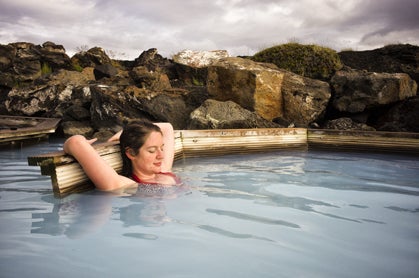
Soaking in the Myvatn Nature Baths. Photo by David Clifford.
TRAVELING TO THE NORTH
Getting to Akureyri
After arriving at Keflavik International Airport near Reykjavik, you can:
- Rent a car—recommended for accessing most trailheads.
- Take a local flight to Akureyri’s regional airport (45 minutes). >Take the route 57 Strætó bus (six hours).
The local city bus in Akureyri is free.
Best Time to Go
- June through August.
Where to Stay
- Skjaldarvik Guesthouse, just a five-minute drive from town, offers quaint bedrooms, an organic café, horseback-riding tours, a hot tub and an honor-system, serve-yourself bar. www.skjaldarvik.is
- Sveinbjarnargerdi Inn, 10 minutes from Akureyri, provides a charming country retreat overlooking the water. www.countryhotel.is/en
- Campgrounds, as well as dispersed camping, are available all over Iceland.
Good Eats
- RUB23 Sushi, Seafood and Steakhouse in Akureyri—Choose your meat or fish, choose your “rub” (marinade) and enjoy the fancy, funky décor. www.rub23.is
- Vogafjos Café near Lake Myvatn—Locavores will rejoice at this tasty, farm-to-table cuisine ranging from Geysir bread to fresh milk to pan-fried lamb.www.vogafjos.net
- Don’t forget to sample Icelandic specialties: hot dogs, skyr (similar to Greek yogurt), Arctic char and chocolate-covered licorice.
Be A Tourist
- While Husavik is known as the whale-watching capital of Iceland, Arctic Sea Tours in the nearby town of Dalvik sees fewer tourists, and offers the bonuses of hotel pickup in Akureyri, sea angling and a post-tour, fresh-cod grillout. www.arcticseatours.is
- Take a dip in the alkaline, mineral-rich, chlorine-free Myvatn Nature Baths. www.jarbodin.is
- Riding Icelandic horses is the quintessential tourist experience. The Skjaldarvik Guesthouse offers 1.5-hour tours, followed by a hot-tub soak. www.skjaldarvik.is
Trail Running in Northern Iceland
Trails
- Dettifoss Trail, 33K point-to-point from Dettifoss to Asbyrgi, with many options for side trail excursions. Pick up a map at Asbyrgi Visitor Center.
- Lake Myvatn Trails, all distances. Pick up a map at the Reykjahlið Visitor Center or town swimming pool.
- Askja Trail, 95K point-to-point from Herðubreiðarlindir to Svartárkot-farm, with huts along the way. Make advance reservations. www.ffa.is/en
Races
It can be difficult to track down info online about Iceland’s trail races. Visit www.arcticrunning.is for registration help or packages that combine race entry with local accommodations and even transport from Akureyri.
- Thorvaldsdalur Wilderness Run (June), 25K. The oldest trail run in Iceland, just outside of Akureyri.
- Four Forests Run (July), 4.3K, 10.3K, 17.7K or 30.6K. Put on by locals on the banks of the Fnjóská river.
- Glerardalshringurinn 24 Peaks (July), 50K. Technically a 24-hour group hike, not a race, this 50K route sports 13,000 feet of climb and summits 24 peaks around Akureyri, including Iceland’s tallest peak, Kerling (5045 feet). www.24×24.is
- Dettifoss Trail Run (August), 33K, 21K or 13K. Waterfalls, canyons, birch forests. www.jokulsarhlaup.is
- The Arctic Run (September), 12K or 24K. A new race in 2012; hop a ferry or plane to Grimsey, a gem of an island on the Arctic Circle.
Resources
- Arctic Running offers guided trail-running tours, ranging from short jaunts in and around Akureyri (and Reykjavik) to 30-kilometer, day-trip excursions to multi-day, supported running adventures through Iceland’s wilds. www.arcticrunning.is
- The Vatnajökull National Park website has detailed trail beta and tips, PDF maps and camping info. www.vatnajokulsthjodgardur.is
- Visit Akureyri also has info about trails and hiking/running routes in the north, as well as general tourist resources. www.visitakureyri.is/en
